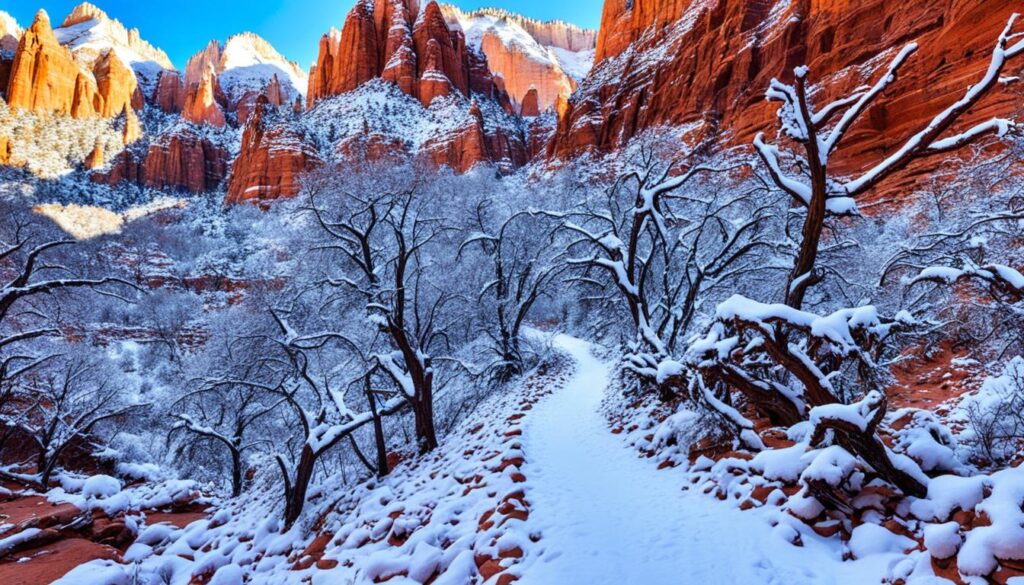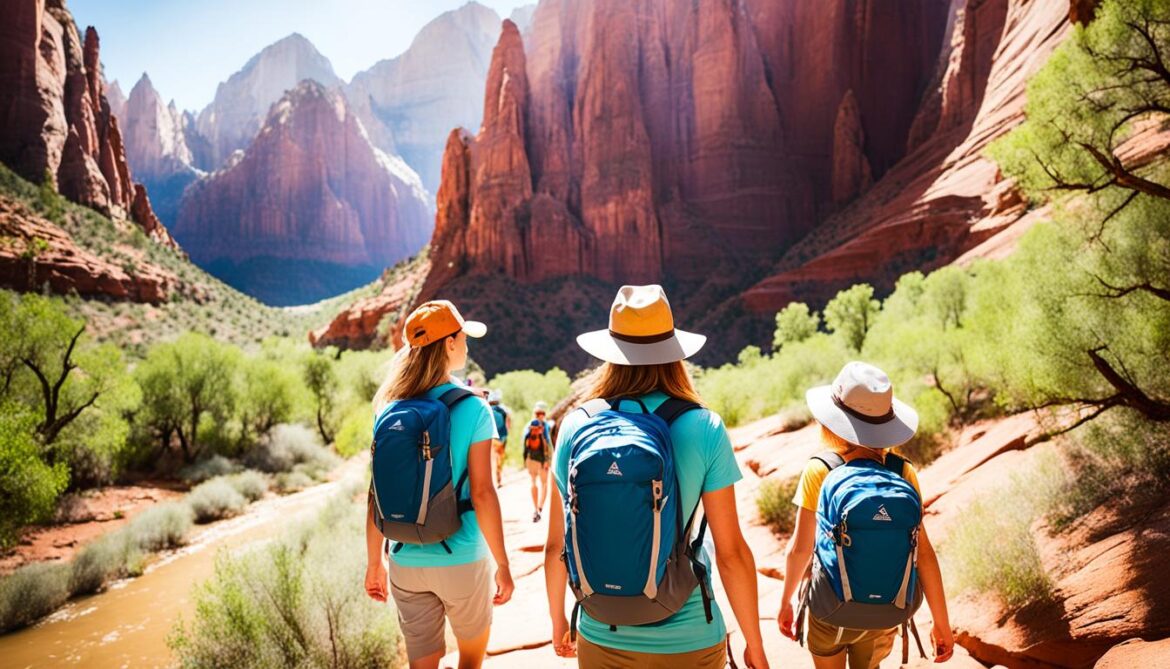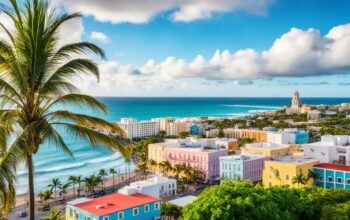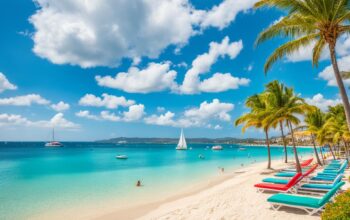When planning a visit to Zion National Park, it’s important to consider the ideal season for the best experience. The park offers stunning scenery and a variety of outdoor activities, but different seasons bring different weather conditions, crowds, and accessibility. To make the most of your trip, it’s essential to know when to go. In this guide, we will provide a detailed overview of each season in Zion National Park and share insider tips for the best time to visit.
Visiting Zion in the Summer (May-September)
Summer is a popular time to visit Zion National Park due to the beautiful greenery and the opportunity to play in the Virgin River. The park bursts with life as vibrant wildflowers bloom and the surrounding landscapes come alive. However, it’s important to be prepared for the challenges that come with the peak season.
The summer months in Zion National Park bring intense heat, with temperatures often exceeding 100 degrees Fahrenheit. It’s crucial to stay hydrated and protect yourself from the scorching sun by wearing sunscreen, a hat, and lightweight, breathable clothing.
The summer season also attracts large crowds as families and tourists flock to experience the park’s natural wonders. To make the most of your summer visit, consider starting your day early to beat the crowds and the increasingly hot temperatures. The park tends to be busiest between 10 am and 3 pm, so planning your activities outside of these hours can provide a more enjoyable and serene experience.
“Zion National Park in the summer is a true testament to the power and beauty of nature. The vibrant greenery and the glistening waters of the Virgin River create a picturesque backdrop for adventure and exploration. However, it’s important to come prepared with plenty of water, sun protection, and the willingness to beat the crowds. The summer season can be challenging, but the rewards are endless.” – Mark Jenkins, Outdoor Enthusiast
While visiting Zion National Park in the summer, it’s important to be aware of the monsoon season that typically occurs from July to September. The sudden and heavy downpours can lead to flash floods, making certain areas of the park unsafe. Before embarking on any hikes or excursions, check the weather forecast and stay informed about any alerts or closures related to flash floods.
Despite the challenges, a summer visit to Zion National Park can be incredibly rewarding. The stunning landscapes, accessibility to hiking trails, and the chance to cool off in the refreshing Virgin River make it a memorable experience. By taking necessary precautions and planning ahead, you can make the most of your summer visit to this captivating national park.
Visiting Zion in Spring/Fall (Oct-Nov & March-April)
Spring and fall are the perfect seasons to plan your trip to Zion National Park. During this time, you can enjoy milder temperatures and fewer crowds, providing an optimal experience for hiking and exploring the park’s natural beauty.
In the spring, which spans from March to April, the park starts to come alive with vibrant blossoms and fresh greenery. However, it’s important to note that early spring can bring some challenges due to runoff from snowfall. This may result in trail closures for safety reasons, as the trails can be slippery or impassable. Keeping an eye on the park’s website or checking with park rangers beforehand can help you plan your visit accordingly.
In the fall, from October to November, Zion National Park transforms into a breathtaking display of autumn colors. The crisp air and comfortable temperatures make it an ideal time to explore the park’s numerous hiking trails. From easy walks along the Virgin River to challenging climbs up Angel’s Landing, there are options for every level of outdoor enthusiast.
During the spring and fall seasons, it’s recommended to dress in layers to accommodate temperature changes throughout the day. Wearing comfortable hiking shoes and packing essential items such as sunscreen, water bottles, and snacks is also essential.
Reduced Shuttle Schedules and Avoiding Crowds
During the spring and fall offseason, it’s important to be aware of reduced shuttle schedules. The Zion Canyon Shuttle operates from late March to early November and offers a convenient way to navigate the park. However, during the off-peak months of October and April, the shuttle service may have limited routes and operating hours. It’s crucial to check the current schedules to ensure you can efficiently explore the park.
To avoid overcrowding, consider planning your trip to Zion National Park during weekdays instead of weekends. Weekdays tend to be less busy, allowing you to have a more peaceful and enjoyable experience. Additionally, planning your trip in advance and making reservations for accommodations and popular activities can help ensure a smooth and seamless visit.
| Spring | Fall |
|---|---|
| Milder temperatures | Milder temperatures |
| Runoff from snowfall may lead to trail closures | Spectacular autumn colors |
| Vibrant blossoms and fresh greenery | Comfortable temperatures |
Visiting Zion in the Winter (Dec-Feb)
Winter in Zion National Park offers a unique and breathtaking experience. With fewer crowds, you can have the stunning landscapes and trails more to yourself. However, it’s essential to be prepared for the challenges that come with winter visits.
The cold temperatures can be quite harsh, so make sure to dress in layers and wear appropriate winter gear to stay warm and comfortable. It’s also crucial to be prepared for snowy or icy conditions, especially on the trails. Certain trails may be closed for safety reasons, so it’s important to check the park’s website or inquire with rangers before setting out on your hike.
For added safety on icy trails, consider using gear such as YakTrax or microspikes for better traction. These will help prevent slips and falls, ensuring you can enjoy your winter hikes with peace of mind. Safety should always be a top priority.
While wildlife may be less active during the winter months, the park still offers plenty of opportunities for sightseeing and photography. The snowy landscapes create a stunning backdrop for capturing memorable moments. Be sure to bring your camera and capture the beauty of Zion in its winter glory.
However, it’s important to note that winter conditions can impact accessibility and park services. Some facilities, campgrounds, or shuttle services may be closed or operate on a limited schedule. It’s best to check for any road closures and plan your visit accordingly.
Overall, visiting Zion National Park in winter is a wonderful experience for those seeking solitude and a unique perspective of this natural wonder. Just make sure to be prepared for the cold temperatures, potentially challenging trail conditions, and limited services. With the right gear and precautions, you can have an unforgettable winter adventure in the park.

| Trail Name | Availability |
|---|---|
| Angel’s Landing | Closed due to icy conditions |
| The Narrows | Open with potential icy sections |
| Observation Point | Open but requires proper gear for snowy conditions |
| Emerald Pools | Open with potential icy areas |
| Canyon Overlook | Open but may require proper gear for snowy or icy conditions |
When To Not Visit Zion
While planning your trip to Zion National Park, it’s important to consider the times to avoid due to heavy crowds. The park is a popular destination year-round, but certain periods can make it challenging to fully enjoy its attractions. Holidays like Labor Day, Memorial Day, Thanksgiving, and Christmas (weather permitting) tend to draw large crowds, sometimes leading to the park reaching maximum capacity.
To have a more peaceful experience and avoid the crowds, it’s recommended to plan your visit during off-peak times and weekdays. By doing so, you’ll be able to explore Zion National Park at your own pace, without feeling overwhelmed by the number of visitors.
When it comes to enjoying the beauty and tranquility of Zion National Park, timing is key. By following these tips and planning your visit accordingly, you’ll be able to have a more enjoyable and less crowded experience, immersing yourself in the stunning landscapes and natural wonders that this national park has to offer.







